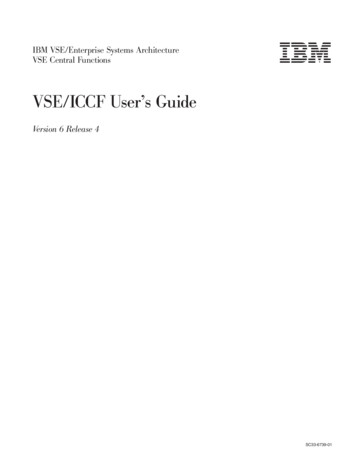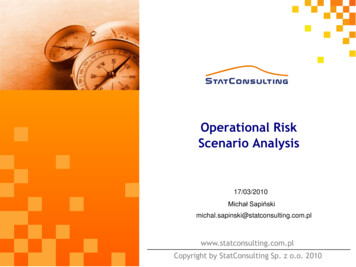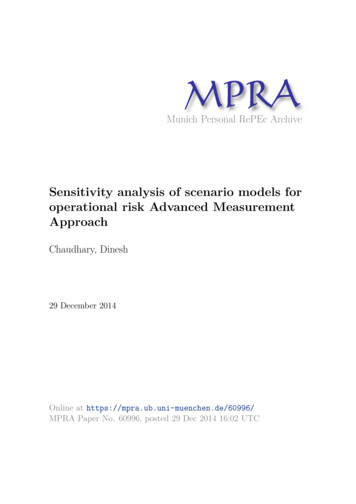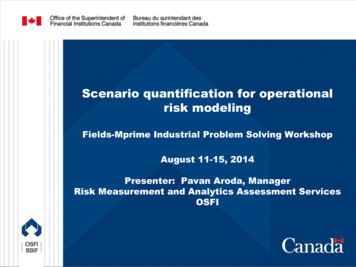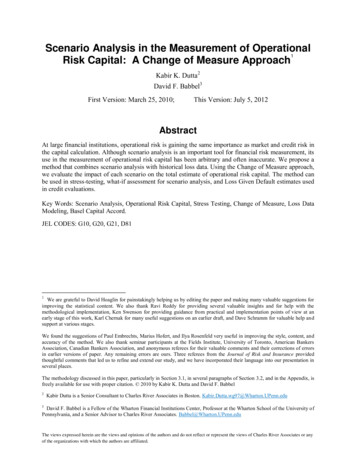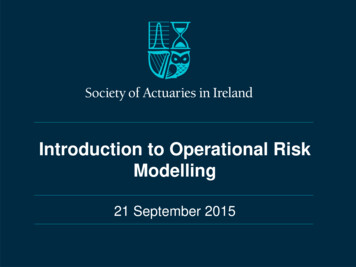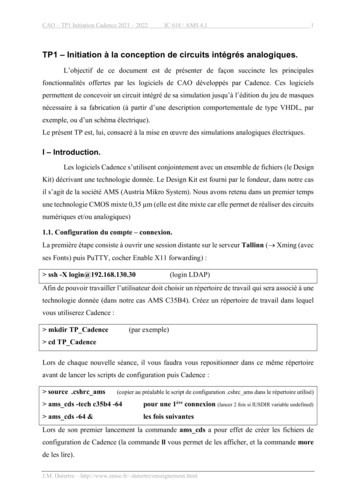
Transcription
DOI: 10.18267/j.pep.385OPERATIONAL RISK – SCENARIO ANALYSISMilan Rippel, Petr Teplý*Abstract:This paper focuses on operational risk measurement techniques and on economic capitalestimation methods. A data sample of operational losses provided by an anonymous CentralEuropean bank is analyzed using several approaches. Multiple statistical concepts such as theLoss Distribution Approach and the Extreme Value Theory, including scenario analysis method,are considered. Custom plausible loss events defined in a particular scenario are merged with theoriginal data sample and their impact on capital estimates and on the financial institution as a wholeis evaluated. Two main questions are assessed – what is the most appropriate statistical methodto measure and model operational loss data distribution and what is the impact of hypotheticalplausible events on the financial institution. The g&h distribution was evaluated to be the mostsuitable one for operational risk modeling. The method based on the combination of historical lossevents modeling and scenario analysis provides reasonable capital estimates and allows for themeasurement of the impact of very extreme events on banking operations.Keywords: operational risk, scenario analysis, economic capital, loss distribution approach,extreme value theory, stress testing.JEL Classification: G21, G32, C151. IntroductionThere are some widely known operational risk events of severe magnitude thatoccurred in the last few years; the most publicly known examples of operational riskinclude a loss of 7.3 billion at Société Générale in 2007 or more recently the 65billion Ponzi scheme by Mr. Bernard Madoff and the 8 billion bank fraud of SirAllen Stanford. Operational risk events also occurred during the pending global crisis,such as failed risk management processes or mortgage frauds committed by applicantswhen cheating on their income in order to secure a loan (Teplý, 2010).*Institute of Economic Studies, Faculty of Social Sciences, Charles University In Prague,Opletalova 26, CZ – 110 00, Praha 1 (milanrippel@seznam.cz; teply@fsv.cuni.cz). The findings,interpretations and conclusions expressed in this paper are entirely those of the authorsand do not represent the views of any of the authors' institutions. Financial support for thisresearch from The Grant Agency of Charles University (GAUK 31610/2010 – Optimal Methods ofOperational Risk Management); The Czech Science Foundation, project The Institutional Responsesto Financial Market Failures, under No. GA P403/10/1235; The IES Institutional ResearchFramework 2005–2010 under No. MSM0021620841; and The Czech Science Foundation, projectThe Implications of The Global Crisis on Economic Capital Management of Financial Institutionsunder No. GA 403/10/P278 is gratefully acknowledged.PRAGUE ECONOMIC PAPERS, 1, 2011 23
DOI: 10.18267/j.pep.385Additionally, the New Basel Capital Accord (Basel II), valid since 2007, newlyintroduced a capital requirement for operational risk (in addition to credit and marketrisk). This fact has further fostered the focus on operational risk management.In this paper we focus on modelling and stress testing the economic and regulatorycapital set aside to cover unexpected operational risk losses of an anonymous CentralEuropean bank (BANK). There are two main questions this paper is focused on:1. What is the appropriate statistical method to model operational risk loss data distribution and measure reasonable capital estimates for the institution?2. What is the impact of extreme events defined in particular extreme case scenarioson the capital estimates and on the financial institution?Several statistical distributions are used to model loss severity distribution and computecapital estimates. It is expected that the best results will be provided by a distributionthat can reasonably model the body as well as the heavy right tail of the data sample.On the other hand, techniques that focus just on the tail of the distribution might notprovide consistent results if the tail is contaminated by additional extreme loss eventsdefined by scenarios. The distribution that is expected to be the most suitable formodelling the operational risk data is the g&h distribution used by Dutta, Perry (2007).So the test hypotheses can be stated as:H1: The g&h distribution provides consistent capital estimates for scenario analysis method;H2: Extreme Value Theory (EVT) provides consistent capital estimates for scenario analysis method.Once these hypotheses are assessed, the effects of unanticipated extreme events on thefinancial institution can be evaluated. It is assumed that the bank would not be ableto cover the worst case joint scenario losses, because the loss amounts would exceedbank capital reserves. On the other hand, the bank should be able to cover average jointscenario losses.The first rigorous studies on operational risk management were introduced inlate 1990s, through published studies by Prof. Embrechts. Given the scarcity andconfidentiality of operational risk loss data, there are only a few papers that explorethe specifics of operational risk data and are able to measure operational risk exposurewith the accuracy and precision comparable with other sources of risk. The mostcomprehensive studies are de Fontnouvelle, Jordan, Rosengren (2005), Degen,Embrechts, Lambrigger (2007), Embrechts, Frey, McNeil (2005), Mignolla, Ugoccioni(2006), Chernobai, Rachev, Fabozzi (2007) and Dutta, Perry (2007). A scenarioanalysis method, the method used in this paper, is discussed in papers from Cihak(2004), Arai (2006), Kuhn, Neu (2004) or Rosengren (2006). More recently, Chalupka,Teplý (2008), Rippel, Teplý (2010) and Teplý (2010) provide a detailed overview ofoperational risk management methods.This paper is organized as follows: Section 2 provides an overview of operationalrisk concepts related to Basel II requirements. Section 3 provides an overview ofthe methodology used. Section 4 analyzes the data sample of BANK and proposesdistributions that can best model the data sample. Section 5 provides a theoreticaloverview of stress testing and scenario analysis methodology. In Section 6 the loss24 PRAGUE ECONOMIC PAPERS, 1, 2011
DOI: 10.18267/j.pep.385events defined in particular scenarios are merged with the original data sample andnew capital estimates are computed. Finally, Section 7 provides a conclusion andproposes areas for future research.2. Operational Risk Background and Basel II requirements2.1 Basic termsThe most common definition of operational risk is given in Basel II as “the risk ofloss resulting from inadequate or failed internal processes, people and systems orfrom external events. This definition includes legal risk, but excludes strategic andreputational risk.” (BCBS, 2006) The operational risk encompasses those risks, notcovered under credit and market risk that have a measurable financial impact.For operational risk modelling, it is crucial to distinguish between regulatory andeconomic capital. Regulatory capital is the amount of capital used for capital adequacycomputation under Basel II. Economic capital is “a buffer against future, unexpectedlosses brought about by credit, market, and operational risks inherent in the businessof lending money” (Mejstřík, Pečená and Teplý, 2008). Banks are expected to keepin reserve the necessary amount of economic capital to comply with Basel II Pillar IIrules.Regulatory capital covers unexpected losses only to a VaR confidence level 99.9%set by Pillar I of Basel II. For economic capital, banks typically set the VaR confidencelevel according to their operational risk exposure or use alternative measurementapproaches - i.e. expected shortfall (Chernobai, 2007)2.2 Basel II operational risk measurement techniquesBasel II sets three operational measurement methodologies for calculating operationalrisk capital charge in a continuum of increasing sophistication and risk sensitivity(BCBS, 2006). The first two approaches – Basic Indicator Approach (BIA) andStandardized Approach (SA) - are top-down approaches, because the capital chargeis allocated according to a fixed proportion of a three-year average of the sum ofnet interest and net non-interest income (Basel Income Ratio). The third approach –Advanced Measurement Approach (AMA) – is a bottom-up approach, because thecapital charge is estimated based on actual internal operational risk loss data.Under the AMA, the regulatory capital requirement equals the risk measuregenerated by the bank’s internal operational risk measurement system using thequantitative and qualitative criteria that are given in Basel II. One of the AMAtechniques is the Loss Distribution Approach (LDA) which uses statistical methods tomeasure the regulatory and economic capital a bank should allocate. LDA works withthe database of past operational risk events. Another AMA technique is the ScenarioAnalysis (SCA) which is further described in Section 5.PRAGUE ECONOMIC PAPERS, 1, 2011 25
DOI: 10.18267/j.pep.3853. Methodology3.1 General remarksEmpirical evidence proves that operational risk data have certain specifics, that causestechniques used for the assessment of credit and market risks unsuitable for operationalrisk management. From this point of view, operational risk management has morein common with insurance and actuarial mathematics. Consequently, insurancemethodology can be successfully applied to operational risk assessment, for examplewhen considering Extreme Value Theory (EVT).The operational risk data are specific by the fact that there exist infrequent eventsthat cause very severe losses to financial institutions. “Banks must be particularlyattentive to these losses as these cause the greatest financial consequences to theinstitutions” (Chernobai, Rachev and Fabozzi, 2007).On the other hand, the majority of the loss events are characterized by highfrequency but low severity. Those events are relatively unimportant for a bank andcan often be prevented using risk mitigation techniques or covered by provisions.When considering statistical distribution of operational risk loss severity data the“existing empirical evidence suggest that the general pattern of operational loss datais characterized by high kurtosis, severe right-skewness and a very heavy right tailcreated by several outlying events” (Chernobai, 2007). Distributions fitting such dataare called leptokurtic. As will be shown later, the data sample provided by BANKexhibits the same characteristics.3.2 Models for operational risk measurementTwo fundamentally different approaches are used to model operational risk: The top-down approachThe bottom-up approachThe top-down approach quantifies operational risk without attempting to identify theevents or causes of losses while the bottom-up approach quantifies operational risk ona micro-level being based on identified internal events. The top-down approach groupincludes, among others, the Risk Indicator models that rely on a number of operationalrisk exposure indicators to track operational risks and the Scenario Analysis and StressTesting Models that are estimated based on the what-if scenarios.The bottom-up approaches include actuarial type models that have two keycomponents – frequency and loss severity distributions for modelling historicaloperational risk loss data sample. The capital charge is then computed as the value ofVaR0.999 measure of the one-year aggregate distribution loss.3.3 Frequency distributionsThe studies based on empirical data suggest that choice of frequency distribution is notas important as an appropriate choice of loss severity distribution (de Fontnouvelle, deJesus-Rueff, Jordan and Rosengren, 2003). The survey of studies done by Chernobai,26 PRAGUE ECONOMIC PAPERS, 1, 2011
DOI: 10.18267/j.pep.385Rachev and Fabozzi (2007) suggest that the Poisson distribution will be a reasonablesolution for modelling operational risk frequency. Features of Poisson distribution areexplained in Chalupka, Teplý (2008) or Rippel (2008).3.4 Loss severity distributionsSeveral distributions were used to model loss severity. The distributions differ in thenumber of parameters they use. The list ranges from a simple one parameter exponentialover the two parameter gamma, Weibull and lognormal distributions to four parameterg&h distribution (see de Fontnouvelle, de Jesus-Rueff, Jordan and Rosengren, 2003 orRippel, Teplý, 2008).The g&h distribution is the most advanced parametric distribution that will beused in this paper. It is “a strictly increasing transformation of the standard normaldistribution Z defined by:X g ,h ( Z ) A 1 2hZB gZ(e 1)e 2gwhere A, B, g and h 0 are the four parameters of the distribution” (Dutta and Perry,2008). The parameters are estimated using the following algorithm. Â is equal tomedian of the data sample X0,5 . The ĝ parameter is defined as a median of 1 X X 0,5 ,g p log 1 p Z X Xp p 0,5where Xp is the pth percentile of g-distribution and Zp is the pth of standard normaldistribution. The other two parameters are determined using the OLS regression of log(UHS) on Z p2 2 , where UHS is an upper half spread defined asUHS g ( X 1 p X 0,5 ).e gZp 1The B̂ is estimated as the exponentiated value of the intercept of this regression andthe ĥ is estimated as the coefficient of that regression.3.5 Extreme Value TheoryExtreme Value Theory (EVT) is a branch of statistics that focuses on the extremephenomena – the rare events that are situated in a tail of a particular probabilitydistribution. There are several techniques for the EVT – each of them uses differentmethod to pick up the low frequency/high severity loss events. They differ in how theyset a threshold to cut loss data distribution into two parts – the body and the tail. Underthe EVT, the body is being modeled using a different method (e.g. empirical sampling)and the tails are being modeled using specific EVT methods. There are two ways toselect tail observations from a data sample – Block Maxima Method (BMM) and PeakOver Threshold Method (POTM).PRAGUE ECONOMIC PAPERS, 1, 2011 27
DOI: 10.18267/j.pep.3853.5.1Block maxima methodThe Block Maxima Method (BMM) divides data sample into independent blocks ofthe same size and considers the highest observation from such a block. This modelwould be useful, if the extreme events were equally distributed over the whole timeinterval. “For very large extreme loss observation x, the limiting distribution of suchnormalized maxima is the Generalized Extreme Value (GEV)” (Chernobai, Rachev andFabozzi, 2007). The probability density distribution function of GEV distribution hasa form of:f ( x; , , ) 1 x 1 1 1e [1 (x )] 1 x for 1 0, where x refers to block maxima observations, μ R is the location parameter, σ 0 isthe scale parameter and ξ is the shape parameter. The GEV distribution can be dividedinto three cases based on the value of the shape parameter (Chalupka and Teplý,2008). The most important case called the Fréchet or the type II extreme value (EV)distribution is for ξ 0. The tail of the Fréchet distribution is slowly varying and thussuitable for modelling high severity operational risk data.3.5.2Peak over threshold methodThe POTM uses all observations that exceed certain high threshold level. As arguedby Embrechts, Frey, McNeil (2005), these models are more frequently used in practicefor operational risk exposure measurement. The limiting distribution for the POTM isthe generalized Pareto distribution (GPD) with the probability density function in theform of:1( 1)1 (x ) f ( x; , , ) 1 , where x refers to the data exceeding the threshold, μ R is the location parameter,σ 0 is the scale parameter and ξ is the shape parameter.Similarly to GEV, also the GPD has special cases based on the value of the shapeparameter. The most important case from operational risk modelling point of view iswhen ξ 0. In this case the GPD has very heavy tails. The GPD parameters can beagain estimated by using either the MLE or the PWM methods – for more details seeTeplý, Chalupka (2008).A critical task for designing the GPD distribution is to set an appropriate thresholdlevel. This level should be set to be sufficiently high to fit extreme events. But onthe other hand, the filtered data sample should not be limited too much in order toprovide reasonable statistical evidence. Several approaches to solve this optimizationtask exist. The most commonly used one relies on the visual observation of the meanexcess plot, which is defined as the mean of all differences between the values of thedata exceeding threshold level u and u. In case of the GPD the empirical mean excessfunction can be formalized into the following equation:28 PRAGUE ECONOMIC PAPERS, 1, 2011
DOI: 10.18267/j.pep.385en (v) x v I v x I v x nj 1jnj 1jj 1 1 uwhere v is the value above threshold level u. Threshold values against mean excessvalues provide the mean excess plot. If the data supports a GPD model, then thisplot should become increasingly linear for higher values of v. A general practice isthen to choose such u for which the mean excess plot is roughly linear. Several otherapproaches for choosing the threshold exist – the most simple one is just to define theright tail as five or ten percent of the observations with highest loss.3.6 Goodness of fit testsThe fit of distributions chosen should be tested by a set of Goodness of Fit Tests (GOFT)in order to avoid model risk. As Chalupka and Teplý (2008) note, an underestimatedVaR would jeopardize the long-term ability of a bank to maintain a sufficient amountof capital reserves to protect against catastrophic operational losses, while a severelyoverestimated VaR would limit the amount of funds available for investment. There aretwo ways how to assess the GOFT – either by using in-sample GOFTs or backtesting.Backtesting is the opposite approach to stress testing which questions validity ofa chosen model.GOFTs are divided into two classes – visual tests and formal tests. Visual GOFTscompare empirical and hypothesized distributions by plotting them to a chart andcomparing their characteristics. The most commonly used visual test is QuantileQuantile (QQ) plot which plots empirical data sample quantiles against the quantiles ofthe distribution that is being tested for fit – for more details on the QQ plot see Dutta,Perry (2007) or Rippel (2008).Formal GOFTs test whether the data sample follows a hypothesized distribution.Empirical distribution function-based tests directly compare the empirical distributionfunction with the fitted distribution function. The tests belonging to this group arethe Kolmogorov-Smirnov test (KS) and the Anderson-Darling (AD) test. Both ofthem state the same hypothesis but use different test statistics - for more details seeChalupka, Teplý (2008) or Rippel (2008).3.7 Aggregate loss distribution and capital charge estimatesOnce the frequency and severity loss distributions are evaluated, an aggregatedrisk exposure of the bank should be estimated. Both types of distributions are to beaggregated to a single model which estimates the total loss over a one-year period.The measure used for the estimation of required capital charge is the Value-at-Risk(VaR). In the context of operational risk, VaR is the total one-year amount of capitalthat would be sufficient to cover all unexpected losses with a high level of confidencesuch as 99.9% (Chernobai, Rachev and Fabozzi, 2007).Due to the fact that the cumulative distribution function is not linear in X nor inN, analytic expressions for the compound distribution function do not exist and thusthe function must be evaluated numerically. The most common technique relies onPRAGUE ECONOMIC PAPERS, 1, 2011 29
DOI: 10.18267/j.pep.385numerical approximation of the compound distribution function using the Monte Carlosimulations of loss scenarios. The algorithm is as follows:1. Simulate a large number of Poisson random variates and obtain a sequencen1, n2, nMC representing scenarios of the total number of loss events in a one-yearperiod.2. For each of such scenarios nk simulate nk number of loss amounts using a specifiedloss severity distribution.3. For each of such scenarios nk sum the loss amounts obtained in the previous step inorder to obtain cumulative one-year losses.4. Sort the sequence obtained in the last step to obtain the desired aggregate lossdistribution.The number of simulated observations differs. We will use 50,000 simulations for thepurposes of this paper.4. Empirical Data Sample AnalysisThe data sample provided by BANK consists of 657 loss events. The followingassumptions about the data sample were made: Exchange rate and inflation impacts are not considered, nominal values in EUR areused. The data sample is truncated from below, but the threshold is set to a very lowvalue, so we do not use corrections for left truncation bias. The impact of insurance is not considered. While the SA uses 15% of Basel Income Ratio as a regulatory capital charge it isexpected that using the LDA approach the reasonable interval for capital charge is5-15% but this range might be broader for some banks. For instance, small bankswith lower income might report higher the AMA than the SA as a result of incorporating of extreme losses in the model through stress testing.The statistics for the whole sample show a significant difference between the mean andthe median and a very high standard deviation which signals a heavy right tail1. Thesame information is given by the skewness measure. The high value of the kurtosismeasure signals that the high standard deviation is caused by infrequent extremeobservations. These findings suggest that the data sample provided by the BANKexhibits the specific features of operational risk data.Table 1Data Sample Statistics – Whole Sample in EURMeanMedianStd. urce: BANK data sample.1While 80% losses are lower than EUR 20,000 and 95% are lower than EUR100,000, there are 4cases where the loss exceeds EUR 2,000,000.30 PRAGUE ECONOMIC PAPERS, 1, 2011
DOI: 10.18267/j.pep.385The procedure described in Section 3.7 was used to aggregate the loss frequencyand the loss severity distributions. The Monte Carlo simulation method with 50,000trials was used for the parameter estimation as well as for the aggregation function.The regulatory capital estimates are provided as a percentage relative to the BANKaverage Basel Income Ratio over the last three-year period as required by CNB (2007).The regulatory capital is being measured as the ratio of VaR0.999 / Basel Income Ratio.The fit of the distributions to the sample data is evaluated by using the QQ plot, theKS and the AD tests. If the test statistics are higher than the critical value, then the nullhypothesis that the particular distribution is able to model the operational risk datasample cannot be rejected.The distributions mentioned above were used for modelling of loss severitydistribution – namely the Empirical Sampling Method, lognormal, Weibull, exponential, gamma and g&h parametric distributions and also EVT approaches – BMMand its two ways to set block maxima (max per month and max per quarter) andPOTM with three ways to cut the extreme observations (max 5%, max 10% and thethreshold method). Details are provided in Rippel (2008) or Rippel, Teplý (2009).Table 2Comparison of the Regulatory and Economic Capital EstimatesDistributionRegulatory CapitalEmpirical2.31%G&H4.43%BMM – MonthPOT – 5%14.95%9.32%Source: AuthorsThe conclusion for the LDA approach on the institution level is that only the g&h,the BMM – max quarter and the POTM – max 5% methods seem to be suitable formodelling the operational risk data for Basel II purposes and thus these methods willbe used for the stress testing purposes. The results of these three methods plus the ESMare provided in the following table.While employing the very high significance levels for EVT methods, the regulatorycapital is being overestimated. Because of the high sensitivity of the EVT methods, itcan be concluded that the g&h method provides more reasonable estimates than anyEVT method used.5. Stress Testing and Scenario AnalysisBecause of the fact that the LDA approach is a historical one – the capital charge isestimated based on historical loss events – alternative methods for the operationalrisk management were developed. One of those methods is the scenario analysis or,generally, the stress testing. This method is supposed to examine whether a financialinstitution would be able to undergo exceptional risk losses. The stress testing shouldbe used as a complementary approach to the VaR based LDA approach in order toPRAGUE ECONOMIC PAPERS, 1, 2011 31
DOI: 10.18267/j.pep.385ensure that a bank would be able to cover the losses even if a bank faces more severerisk events. “Whenever the stress tests reveal some weakness, management must takesteps to manage the identified risks. One solution could be to set aside enough capitalto absorb potential large losses. Too often, however, this amount will be cripplinglylarge, reducing the return on capital” (Jorion, 2007).Stress testing methods are not comparable with each other. Neither the applicationsof the same stress tests to different financial institutions are comparable with eachother, because the results are always bound to the specific risk profile of a financialinstitution. Adopting bad assumptions or using irrelevant scenarios would lead toirrelevant losses. Since the stress tests often define events with a very low probabilityof occurrence, the results become difficult to interpret and it is not clear which actionsshould be taken by the management in order to mitigate the risks. Quite often theresults of stress tests appear unacceptably large and they are just ignored and dismissedas irrelevant. However, it is valuable to evaluate stress test results at different point oftimes and say whether the exposures to operational risk have changed.The scenarios can be divided into two groups based on the type of event they define.The first group uses historical events like the 9/11 terrorist attacks or the unauthorizedtrading in Societé Generalé in 2007. The second group, more widely used in practice,uses hypothetical scenarios. The scenarios are based on plausible risk events that havenot happened yet, but a non-zero probability of their occurrence exists. A scenario canalso be based on an analysis of a new product a bank is going to implement.A typical scenario consists of the description of a complex state of the world thatwould impose an extreme risk event on financial institution, including: probabilitiesand frequencies of occurrence of the particular state of the world, business activitiesimpacted by the event, maximum internal and external loss amounts generated byoccurrence of such event and possible mitigation techniques. Even though sucha scenario claims to be realistic, it is not possible to include all possible risk factorsand features. However, risk managers are trying to define the scenarios, so that theycorrespond to the reality as much as possible (Jorion, 2007).BANK combines all main approaches for the operational risk management –including the scenario analysis. The aim of using scenarios is, as explained above, toget an overview about low frequency events that might have severe impact on BANK.BANK was using eight complex scenarios, which satisfy all the qualitative measures.The details on scenario definitions are provided in Rippel (2008).The losses generated by the eight scenarios were aggregated with the capitalestimates based on the original data sample using the LDA method and the results areevaluated in the following section.6. Applied Scenario AnalysisTwo main approaches were used to aggregate losses generated by the scenarios withthe database of historical events. The first one uses a set of the worst-case losses definedby a particular scenario and aggregates these losses to the historical loss data sample.The second approach calculates an average loss given by probability distribution ofthe loss amounts defined by a particular scenario and aggregates those average lossesto the historical loss data sample. In both cases the statistical distributions mentioned32 PRAGUE ECONOMIC PAPERS, 1, 2011
DOI: 10.18267/j.pep.385above, the g&h, the POT – max 5% and the BMM – max quarter, were used for theseverity distribution of the aggregated loss sample. The Poisson distribution was usedfor the loss frequency. Both distributions were then aggregated and the regulatorycapital estimates were computed by using the VaR.In case of the g&h loss severity distribution, the aggregation method of lossesgenerated by the scenarios with the historical data sample is straightforward, becausethe additional losses are simply added to the database. However, in the EVT approaches,where the body and the tail of the distribution are being modeled by using a differentstatistical distribution, the aggregation algorithm is more complicated, because all ofthe losses generated by the scenarios belong to the tail of the aggregated databasedistribution and thus it directly impacts the EVT methods.6.1 Scenario definitionsThere are two groups of scenarios – first group consists of 8 scenarios (denoted as ID1-8) defined by BANK. The second group consists of 4 scenarios that were created forthe purpose of this paper (“custom scenarios” thereafter).Table 3Historical Scenarios List (loss amounts in EUR ths)IDScenario nameEstimated loss112,00029Unauthorized trading – Kerviel10Process management failure - software loss11External fraud – theft7,30021,180Note: Scenarios 1-8 were took from BANK.23Source: AuthorsThe losses generated by the 8 scenarios defined by BANK were merged with thehistorical loss events using the method explained above. These scenarios include suchevents as an
Keywords: operational risk, scenario analysis, economic capital, loss distribution approach, extreme value theory, stress testing. JEL Classi Þ cation: G21, G32, C15 1. I ntroduction There are some widely known operational risk events of severe magnitude that occurred in the last few years; the most publicly known examples of operational risk

